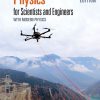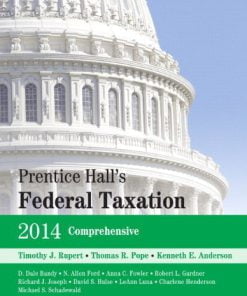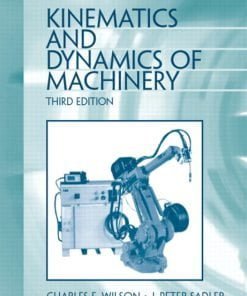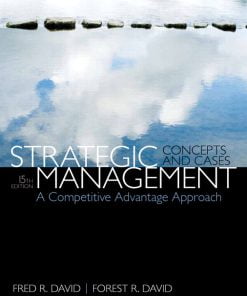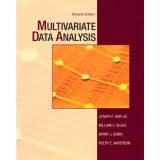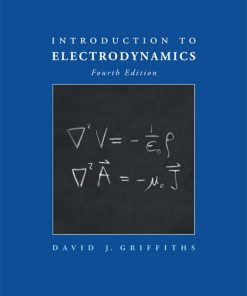Solution Manual for Fundamentals of Heat and Mass Transfer 8th Edition Bergman
$35.00 Original price was: $35.00.$26.50Current price is: $26.50.
Solution Manual for Fundamentals of Heat and Mass Transfer 8th Edition Bergman
Instant download Solution Manual for Fundamentals of Heat and Mass Transfer 8th Edition Bergman pdf docx epub after payment.
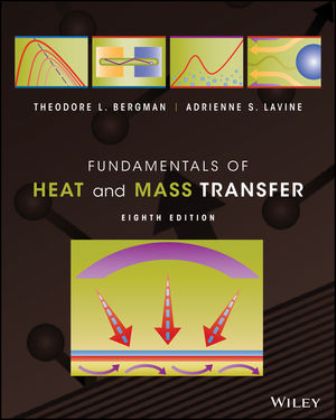
Product details:
Table of contents:
1.1 What and How? 2
1.2 Physical Origins and Rate Equations 3
1.2.1 Conduction 3
1.2.2 Convection 6
1.2.3 Radiation 8
1.2.4 The Thermal Resistance Concept 12
1.3 Relationship to Thermodynamics 12
1.3.1 Relationship to the First Law of Thermodynamics (Conservation of Energy) 13
1.3.2 Relationship to the Second Law of Thermodynamics and the Efficiency of Heat Engines 28
1.4 Units and Dimensions 33
1.5 Analysis of Heat Transfer Problems: Methodology 35
1.6 Relevance of Heat Transfer 38
1.7 Summary 42
References 45
Chapter 2 Introduction to Conduction 47
2.1 The Conduction Rate Equation 48
2.2 The Thermal Properties of Matter 50
2.2.1 Thermal Conductivity 51
2.2.2 Other Relevant Properties 58
2.3 The Heat Diffusion Equation 62
2.4 Boundary and Initial Conditions 70
2.5 Summary 74
References 75
Chapter 3 One-Dimensional, Steady-State Conduction 77
3.1 The Plane Wall 78
3.1.1 Temperature Distribution 78
3.1.2 Thermal Resistance 80
3.1.3 The Composite Wall 81
3.1.4 Contact Resistance 83
3.1.5 Porous Media 85
3.2 An Alternative Conduction Analysis 99
3.3 Radial Systems 103
3.3.1 The Cylinder 103
3.3.2 The Sphere 108
3.4 Summary of One-Dimensional Conduction Results 109
3.5 Conduction with Thermal Energy Generation 109
3.5.1 The Plane Wall 110
3.5.2 Radial Systems 116
3.5.3 Tabulated Solutions 117
3.5.4 Application of Resistance Concepts 117
3.6 Heat Transfer from Extended Surfaces 121
3.6.1 A General Conduction Analysis 123
3.6.2 Fins of Uniform Cross-Sectional Area 125
3.6.3 Fin Performance Parameters 131
3.6.4 Fins of Nonuniform Cross-Sectional Area 134
3.6.5 Overall Surface Efficiency 137
3.7 Other Applications of One-Dimensional, Steady-State Conduction 141
3.7.1 The Bioheat Equation 141
3.7.2 Thermoelectric Power Generation 145
3.7.3 Nanoscale Conduction 153
3.8 Summary 157
References 159
Chapter 4 Two-Dimensional, Steady-State Conduction 161
4.1 General Considerations and Solution Techniques 162
4.2 The Method of Separation of Variables 163
4.3 The Conduction Shape Factor and the Dimensionless Conduction Heat Rate 167
4.4 Finite-Difference Equations 173
4.4.1 The Nodal Network 173
4.4.2 Finite-Difference Form of the Heat Equation: No Generation and Constant Properties 174
4.4.3 Finite-Difference Form of the Heat Equation: The Energy Balance Method 175
4.5 Solving the Finite-Difference Equations 182
4.5.1 Formulation as a Matrix Equation 182
4.5.2 Verifying the Accuracy of the Solution 183
4.6 Summary 188
References 189
Chapter 5 Transient Conduction 191
5.1 The Lumped Capacitance Method 192
5.2 Validity of the Lumped Capacitance Method 195
5.3 General Lumped Capacitance Analysis 199
5.3.1 Radiation Only 200
5.3.2 Negligible Radiation 200
5.3.3 Convection Only with Variable Convection Coefficient 201
5.3.4 Additional Considerations 201
5.4 Spatial Effects 210
5.5 The Plane Wall with Convection 211
5.5.1 Exact Solution 212
5.5.2 Approximate Solution 212
5.5.3 Total Energy Transfer: Approximate Solution 214
5.5.4 Additional Considerations 214
5.6 Radial Systems with Convection 215
5.6.1 Exact Solutions 215
5.6.2 Approximate Solutions 216
5.6.3 Total Energy Transfer: Approximate Solutions 216
5.6.4 Additional Considerations 217
5.7 The Semi-Infinite Solid 222
5.8 Objects with Constant Surface Temperatures or Surface Heat Fluxes 229
5.8.1 Constant Temperature Boundary Conditions 229
5.8.2 Constant Heat Flux Boundary Conditions 231
5.8.3 Approximate Solutions 232
5.9 Periodic Heating 239
5.10 Finite-Difference Methods 242
5.10.1 Discretization of the Heat Equation: The Explicit Method 242
5.10.2 Discretization of the Heat Equation: The Implicit Method 249
5.11 Summary 256
References 257
Chapter 6 Introduction to Convection 259
6.1 The Convection Boundary Layers 260
6.1.1 The Velocity Boundary Layer 260
6.1.2 The Thermal Boundary Layer 261
6.1.3 The Concentration Boundary Layer 263
6.1.4 Significance of the Boundary Layers 264
6.2 Local and Average Convection Coefficients 264
6.2.1 Heat Transfer 264
6.2.2 Mass Transfer 265
6.3 Laminar and Turbulent Flow 271
6.3.1 Laminar and Turbulent Velocity Boundary Layers 271
6.3.2 Laminar and Turbulent Thermal and Species Concentration Boundary Layers 273
6.4 The Boundary Layer Equations 276
6.4.1 Boundary Layer Equations for Laminar Flow 277
6.4.2 Compressible Flow 280
6.5 Boundary Layer Similarity: The Normalized Boundary Layer Equations 280
6.5.1 Boundary Layer Similarity Parameters 281
6.5.2 Dependent Dimensionless Parameters 281
6.6 Physical Interpretation of the Dimensionless Parameters 290
6.7 Boundary Layer Analogies 292
6.7.1 The Heat and Mass Transfer Analogy 293
6.7.2 Evaporative Cooling 296
6.7.3 The Reynolds Analogy 299
6.8 Summary 300
References 301
Chapter 7 External Flow 303
7.1 The Empirical Method 305
7.2 The Flat Plate in Parallel Flow 306
7.2.1 Laminar Flow over an Isothermal Plate: A Similarity Solution 307
7.2.2 Turbulent Flow over an Isothermal Plate 313
7.2.3 Mixed Boundary Layer Conditions 314
7.2.4 Unheated Starting Length 315
7.2.5 Flat Plates with Constant Heat Flux Conditions 316
7.2.6 Limitations on Use of Convection Coefficients 317
7.3 Methodology for a Convection Calculation 317
7.4 The Cylinder in Cross Flow 325
7.4.1 Flow Considerations 325
7.4.2 Convection Heat and Mass Transfer 327
7.5 The Sphere 335
7.6 Flow Across Banks of Tubes 338
7.7 Impinging Jets 347
7.7.1 Hydrodynamic and Geometric Considerations 347
7.7.2 Convection Heat and Mass Transfer 348
7.8 Packed Beds 352
7.9 Summary 353
References 356
Chapter 8 Internal Flow 357
8.1 Hydrodynamic Considerations 358
8.1.1 Flow Conditions 358
8.1.2 The Mean Velocity 359
8.1.3 Velocity Profile in the Fully Developed Region 360
8.1.4 Pressure Gradient and Friction Factor in Fully Developed Flow 362
8.2 Thermal Considerations 363
8.2.1 The Mean Temperature 364
8.2.2 Newton’s Law of Cooling 365
8.2.3 Fully Developed Conditions 365
8.3 The Energy Balance 369
8.3.1 General Considerations 369
8.3.2 Constant Surface Heat Flux 370
8.3.3 Constant Surface Temperature 373
8.4 Laminar Flow in Circular Tubes: Thermal Analysis and Convection Correlations 377
8.4.1 The Fully Developed Region 377
8.4.2 The Entry Region 382
8.4.3 Temperature-Dependent Properties 384
8.5 Convection Correlations: Turbulent Flow in Circular Tubes 384
8.6 Convection Correlations: Noncircular Tubes and the Concentric Tube Annulus 392
8.7 Heat Transfer Enhancement 395
8.8 Forced Convection in Small Channels 398
8.8.1 Microscale Convection in Gases (0.1 μm ≤ Dh ≤ 100 μm) 398
8.8.2 Microscale Convection in Liquids 399
8.8.3 Nanoscale Convection (Dh ≤ 100 nm) 400
8.9 Convection Mass Transfer 403
8.10 Summary 405
References 408
Chapter 9 Free Convection 409
9.1 Physical Considerations 410
9.2 The Governing Equations for Laminar Boundary Layers 412
9.3 Similarity Considerations 414
9.4 Laminar Free Convection on a Vertical Surface 415
9.5 The Effects of Turbulence 418
9.6 Empirical Correlations: External Free Convection Flows 420
9.6.1 The Vertical Plate 421
9.6.2 Inclined and Horizontal Plates 424
9.6.3 The Long Horizontal Cylinder 429
9.6.4 Spheres 433
9.7 Free Convection Within Parallel Plate Channels 434
9.7.1 Vertical Channels 435
9.7.2 Inclined Channels 437
9.8 Empirical Correlations: Enclosures 437
9.8.1 Rectangular Cavities 437
9.8.2 Concentric Cylinders 440
9.8.3 Concentric Spheres 441
9.9 Combined Free and Forced Convection 443
9.10 Convection Mass Transfer 444
9.11 Summary 445
References 446
Chapter 10 Boiling and Condensation 449
10.1 Dimensionless Parameters in Boiling and Condensation 450
10.2 Boiling Modes 451
10.3 Pool Boiling 452
10.3.1 The Boiling Curve 452
10.3.2 Modes of Pool Boiling 453
10.4 Pool Boiling Correlations 456
10.4.1 Nucleate Pool Boiling 456
10.4.2 Critical Heat Flux for Nucleate Pool Boiling 458
10.4.3 Minimum Heat Flux 459
10.4.4 Film Pool Boiling 459
10.4.5 Parametric Effects on Pool Boiling 460
10.5 Forced Convection Boiling 465
10.5.1 External Forced Convection Boiling 466
10.5.2 Two-Phase Flow 466
10.5.3 Two-Phase Flow in Microchannels 469
10.6 Condensation: Physical Mechanisms 469
10.7 Laminar Film Condensation on a Vertical Plate 471
10.8 Turbulent Film Condensation 475
10.9 Film Condensation on Radial Systems 480
10.10 Condensation in Horizontal Tubes 485
10.11 Dropwise Condensation 486
10.12 Summary 487
References 487
Chapter 11 Heat Exchangers 491
11.1 Heat Exchanger Types 492
11.2 The Overall Heat Transfer Coefficient 494
11.3 Heat Exchanger Analysis: Use of the Log Mean Temperature Difference 497
11.3.1 The Parallel-Flow Heat Exchanger 498
11.3.2 The Counterflow Heat Exchanger 500
11.3.3 Special Operating Conditions 501
11.4 Heat Exchanger Analysis: The Effectiveness–NTU Method 508
11.4.1 Definitions 508
11.4.2 Effectiveness–NTU Relations 509
11.5 Heat Exchanger Design and Performance Calculations 516
11.6 Additional Considerations 525
11.7 Summary 533
References 534
Chapter 12 Radiation: Processes and Properties 535
12.1 Fundamental Concepts 536
12.2 Radiation Heat Fluxes 539
12.3 Radiation Intensity 541
12.3.1 Mathematical Definitions 541
12.3.2 Radiation Intensity and Its Relation to Emission 542
12.3.3 Relation to Irradiation 547
12.3.4 Relation to Radiosity for an Opaque Surface 549
12.3.5 Relation to the Net Radiative Flux for an Opaque Surface 550
12.4 Blackbody Radiation 550
12.4.1 The Planck Distribution 551
12.4.2 Wien’s Displacement Law 552
12.4.3 The Stefan–Boltzmann Law 552
12.4.4 Band Emission 553
12.5 Emission from Real Surfaces 560
12.6 Absorption, Reflection, and Transmission by Real Surfaces 569
12.6.1 Absorptivity 570
12.6.2 Reflectivity 571
12.6.3 Transmissivity 573
12.6.4 Special Considerations 573
12.7 Kirchhoff’s Law 578
12.8 The Gray Surface 580
12.9 Environmental Radiation 586
12.9.1 Solar Radiation 587
12.9.2 The Atmospheric Radiation Balance 589
12.9.3 Terrestrial Solar Irradiation 591
12.10 Summary 594
References 598
Chapter 13 Radiation Exchange Between Surfaces 599
13.1 The View Factor 600
13.1.1 The View Factor Integral 600
13.1.2 View Factor Relations 601
13.2 Blackbody Radiation Exchange 610
13.3 Radiation Exchange Between Opaque, Diffuse, Gray Surfaces in an Enclosure 614
13.3.1 Net Radiation Exchange at a Surface 615
13.3.2 Radiation Exchange Between Surfaces 616
13.3.3 The Two-Surface Enclosure 622
13.3.4 Two-Surface Enclosures in Series and Radiation Shields 624
13.3.5 The Reradiating Surface 626
13.4 Multimode Heat Transfer 631
13.5 Implications of the Simplifying Assumptions 634
13.6 Radiation Exchange with Participating Media 634
13.6.1 Volumetric Absorption 634
13.6.2 Gaseous Emission and Absorption 635
13.7 Summary 639
References 640
Chapter 14 Diffusion Mass Transfer 641
14.1 Physical Origins and Rate Equations 642
14.1.1 Physical Origins 642
14.1.2 Mixture Composition 643
14.1.3 Fick’s Law of Diffusion 644
14.1.4 Mass Diffusivity 645
14.2 Mass Transfer in Nonstationary Media 647
14.2.1 Absolute and Diffusive Species Fluxes 647
14.2.2 Evaporation in a Column 650
14.3 The Stationary Medium Approximation 655
14.4 Conservation of Species for a Stationary Medium 655
14.4.1 Conservation of Species for a Control Volume 656
14.4.2 The Mass Diffusion Equation 656
14.4.3 Stationary Media with Specified Surface Concentrations 658
14.5 Boundary Conditions and Discontinuous Concentrations at Interfaces 662
14.5.1 Evaporation and Sublimation 663
14.5.2 Solubility of Gases in Liquids and Solids 663
14.5.3 Catalytic Surface Reactions 668
14.6 Mass Diffusion with Homogeneous Chemical Reactions 670
14.7 Transient Diffusion 673
14.8 Summary 679
References 680
Appendix A Thermophysical Properties of Matter 681
Appendix B Mathematical Relations and Functions 713
Appendix C Thermal Conditions Associated with Uniform Energy Generation in One-Dimensional, Steady-State Systems 719
APPENDIX D The Gauss–Seidel Method 725
APPENDIX E The Convection Transfer Equations 727
E.1 Conservation of Mass 728
E.2 Newton’s Second Law of Motion 728
E.3 Conservation of Energy 729
E.4 Conservation of Species 730
APPENDIX F Boundary Layer Equations for Turbulent Flow 731
APPENDIX G An Integral Laminar Boundary Layer Solution for Parallel Flow over a Flat Plate 735
Conversion Factors 739
Physical Constants 740
Index 741
Problems P-1
Chapter 1 Problems P-1
Chapter 2 Problems P-13
Chapter 3 Problems P-24
Chapter 4 Problems P-49
Chapter 5 Problems P-63
Chapter 6 Problems P-85
Chapter 7 Problems P-95
Chapter 8 Problems P-115
Chapter 9 Problems P-133
Chapter 10 Problems P-149
Chapter 11 Problems P-157
Chapter 12 Problems P-168
Chapter 13 Problems P-189
Chapter 14 Problems P-210
People also search:
Fundamentals of Heat and Mass Transfer 8th Edition
Fundamentals of Heat and Mass Transfer 8th Edition pdf
Fundamentals of Heat and Mass Transfer
what is heat and mass transfer
fundamentals of momentum heat and mass transfer
Related products
Solution Manual
Prentice Hall’s Federal Taxation 2014 Comprehensive Rupert 27th Edition Solutions Manual
Solution Manual
Management Information Systems Managing the Digital Firm Laudon 14th Edition Solutions Manual
Solution Manual
International Accounting Doupnik 4th Edition Solutions Manual
Solution Manual
Solution Manual
Solution Manual
Solution Manual
Solution Manual for Introduction to Electrodynamics, 4/E 4th



